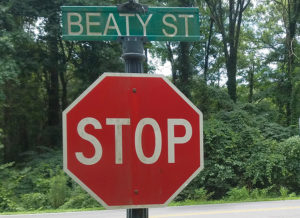
By Dave Vieser. The economic engine of the Golden Crescent continues to purr along nicely, but it looks like developers will have to pay more attention to context. The challenge facing local officials is balancing development with preserving natural beauty, heritage and aesthetics. In Davidson, the Beaty Street project pitted the town’s unique aesthetics—and apparently a majority of residents—against developers and the town government. Residents won, of course, and the long-time mayor and a majority of the town board were turned out in the November election.
Individual towns and cities are taking their own approach to this challenge, some more successfully than others. The friction between residents and town officials in Davidson over several proposed developments demonstrates the sensitivity of the challenge. Parks and natural beauty—perhaps more so than gas stations and franchise hotels—provide intrinsic environmental, aesthetic and recreation benefits, as well as economic development benefits.
Kannapolis has witnessed significant growth. “We have learned lessons from other municipalities about what can occur if positive steps are not taken to manage growth appropriately,” said Mayor Darrell Hinnant. “We knew development would come to our city as a result of its proximity to our urban neighbor.”
Charlotte has been a growth magnet for years, and will continue to be for years to come.
In 2000 Kannapolis initiated Corridor Overlay Districts running along all major corridors. These districts are designed with the priority of protecting natural resources and developing responsibly.
The city is also in the process of completing a new Comprehensive Land Use Plan which will go a step further. Once completed early next year, revisions to the Unified Development Ordinance will follow.
“Our goal is to not just be another city with development ruling us. We want trees, water features, bike paths, green spaces, natural areas, parks and sidewalks. We want neighborhoods and businesses connected to nature. We want this as a reality not just a concept,” Hinnant added.
Concord faced similar challenges. “Requiring sidewalks within new neighborhoods and retail areas have helped the walkability of these communities to try to match what we already have in our vital downtown. We are also slowly retrofitting streets in some older neighborhoods built in the era when sidewalks were not popular, particularly to provide connectivity to schools, shopping areas, greenways and other recreation facilities,” said Mayor Scott Padgett.
Concord allocates a portion of their Transportation Fund, which equals two cents of the town property tax rate, for this purpose. Padgett said many residents are looking for the benefits found in a walkable downtown, so they plan to undertake a broader connectivity study in 2018 on how the city can better connect neighborhoods, retail areas and activity centers, regardless if it is using trails, sidewalks or greenways.
“We also require tree planting and/or other types of landscaping within all types of development to soften the environment,” he said.
One major challenge that has arisen recently are new regulations passed by the General Assembly in Raleigh. “State law now reduces the ability of local governments to impact the look of homes in new residential neighborhoods. However, we still have reasonable requirements for the building materials used for non-residential construction. With all the new road construction going on in our area we are also making plans for the gradual beautification of the medians built as part of these new roads,” Padgett said.
Cornelius, which has also witnessed rapid growth, has used some of the proceeds from a $5.25 million parks bond issue for new trails and greenways. At their Oct. 2 meeting the town also accepted two state DOT grants totaling $1.2 million to assist in their construction of greenways throughout the town.
Davidson is well-known for its quaint downtown college town look and feel. However, several recent large proposed developments have faced stiff opposition. For example, during the past 18 months, the town was pushing the sale and development of 19 acres of town-owned land on Beaty Street for a project known as Luminous. It would have included commercial, retail, residential and a park.
After a profound break with a wide range of concerned residents, the town pulled the plug on the project.
“In an effort to do what’s best for the town at this time, we will not proceed with the “Luminous” proposal on the town’s Beaty Street property,” said Mayor John Woods. Luminous opponents were understandably relieved but Woods also noted that while the current board of commissioners will not pursue development of this land, “options could be considered for the property going forward.”
Part of the challenge is to frame proposed developments in concert with the needs of the community. Vermillion Village in Huntersville appears to have a clear path for development, at a time when several other large mixed-use projects, such as the Beaty Project in Davidson, stall. The Vermillion project will cover about 30 acres of vacant land and is designed to establish a town-center theme between North Church Street and Huntersville-Concord Road.
Local officials say Vermillion has captured current development concepts that. can make mixed use projects succeed. “The project is being developed by Nate Bowman who introduced his earlier version of Vermillion almost two decades ago” said Lake Norman Chamber President Bill Russell. “That development has been very successful and his new project fits in with the town’s master plan to create a sense of place and a revitalized downtown district.”
Communication with residents also plays a major role in the success or failure of developments. In Cornelius, for example, commissioners have recently added a second public hearing to their conditional zoning procedure, at the beginning of the process. The town also has a predevelopment review committee which meets with developers before formal public hearings begin and tells them, face to face, whether their proposal stands a chance of approval. It’s unofficial but developers seem to appreciate the upfront honesty.
With vacant land still available and no signs of an economic slowdown ahead, local town and city officials will need to be especially sensitized to the concerns of both residents and developers, as they walk that fine line between economic development and preserving the aesthetic beauty of the region.

Discussion
No comments yet.